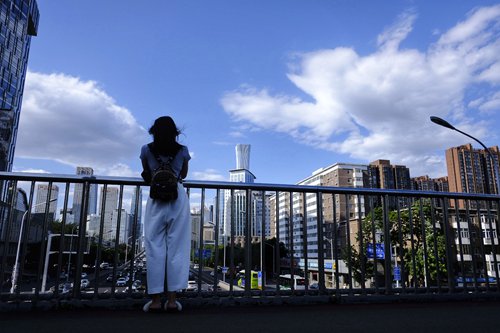
A woman in Beijing enjoys clear skies on Friday with the density of PM2.5 in the city only 0.1 micrograms per cubic meter. Netizens dubbed it as "Beijing cubic meter blue." Photo: IC
The sky above our heads is getting bluer, and the air we breathe cleaner, Chinese Minister of Ecology and Environment Huang Runqiu said on Wednesday, adding that "Beijing blue" has gradually become a new normal for the Chinese capital as the country successfully achieved its phased goals in curbing pollution.
The proportion of days with good air quality in cities at prefecture-level and above across the country reached 87 percent in 2020, an increase of 5.8 percentage points from that in 2015. The figure is 2.5 percentage points higher than the target of the 13th Five-Year Plan, Huang said at a press conference.
Besides, average concentration of PM2.5 dropped to 37 micrograms per cubic meter in cities at prefecture-level and above, a plunge by 28.8 percent compared with that of 2015, surpassing the goal of the 13th Five-Year Plan by over 10 percentage points .
In terms of carbon emission goals, 2020's carbon dioxide emission per unit of GDP reduced by 18.8 percent compared with that of 2015, and forest coverage rate nationwide reached 23.04 percent in 2020. The area of nature reserves accounts for 18 percent of the total land area in China, Huang introduced.
Water quality has also improved. The proportion of good surface water nationwide increased from 66 percent in 2015 to 83.4 percent in 2020, while that of unusable (Class V) water decreased from 9.7 percent in 2015 to 0.6 percent in 2020.
"The 'Beijing blue' has gradually become our new normal," Huang said. The number of days with heavy air pollution in the Chinese capital in 2020 was 10, while in 2015 it was 43, dropping by nearly 80 percent.
As China has made major progress in curbing smog, the next step for environmental governance would be reducing the emissions of volatile organic compounds (VOC), including nitrogen oxide and hydrocarbon gas, produced by vehicles and industrial activity, Wang Gengchen, a research fellow at the Institute of Atmospheric Physics of the Chinese Academy of Sciences, told the Global Times on Wednesday.
"VOCs, mainly emitted from cars, further lead to the issue of ozone pollution, as ozone is produced when VOCs are exposed to sunlight," Wang said.
Among China's 337 cities, 202 met the air quality standard in 2020, accounting for 59.9 percent, 13.3 percent higher than the year before. The cities on average enjoy 87 percent of days with good air quality, which indicates their air quality index was lower than 100, according to the China Environment Report 2020 published by the Ministry of Ecology and Environment in May.


